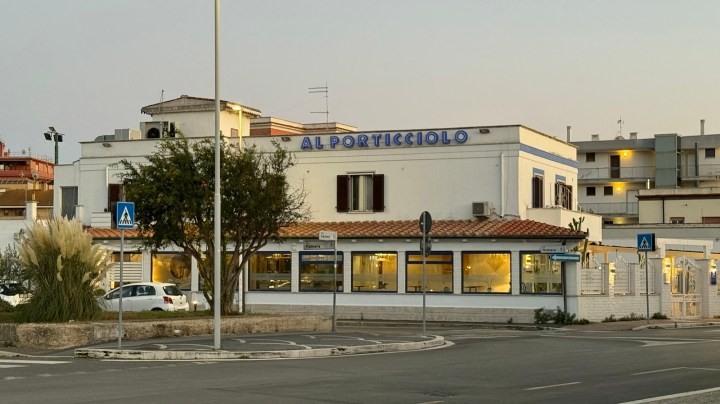
I often use the guides by the Italian magazine Gambero Rosso to choose wines and restaurants. Wines are awarded one, two, or three glasses (bicchieri), trattorias one, two, or three shrimp (gamberi), and restaurants one, two, or three forks (forchette). My sweet spot is restaurants that receive tre forchette from Gambero Rosso but ‘only’ one Michelin star. This usually means excellent value for money, and I often feel they deserve at least a second Michelin star.
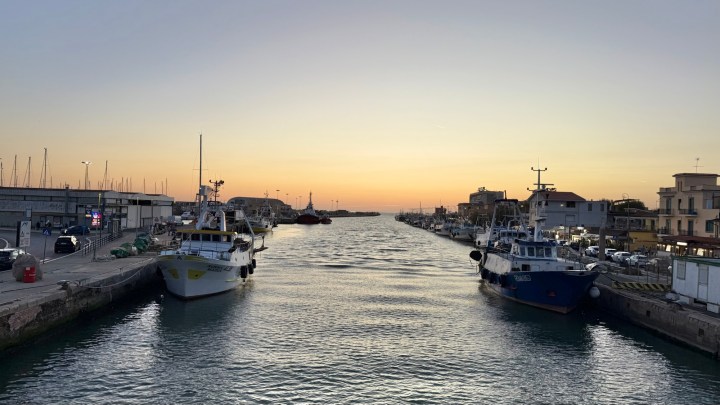
We recently went on a short vacation to the Tuscan coast, flying into Rome because the flight schedule and fares from Amsterdam were better than those to Tuscan airports. Our final stop was the island of Elba, and to avoid the stress of combining a ferry and a flight on the same day, I looked for something near Rome’s Fiumicino airport. And lo and behold: Fiumicino has a restaurant with tre forchette from Gambero Rosso and one Michelin star—Pascucci al Porticciolo. This is the restaurant of chef Gianfranco Pascucci and his wife Vanessa Melis, who manages the front of house. It’s located right by the fishing harbor in Fiumicino, just minutes from the international airport. Given the location, it’s no surprise that this is a seafood restaurant.

The restaurant offers two tasting menus: the “Classic” menu featuring the restaurant’s signature dishes for 120 euros, and Come è profondo il mare… (“How deep is the sea”) for 140 euros, showcasing the chef’s latest creations. We opted for the latter and added a wine pairing—seven glasses for 110 euros.

The first wine was a sparkling Verdicchio from Jesi: Gran Conte Metodo Classico Brut 2019, made using the traditional method (second fermentation in the bottle) and aged for 48 months on the lees. It was very enjoyable, with the characteristic almond aroma of Verdicchio clearly coming through in the sparkling style.

The amuse-bouches were delightful. The first resembled a starfish—crispy, made from potato, and filled with tuna sauce.
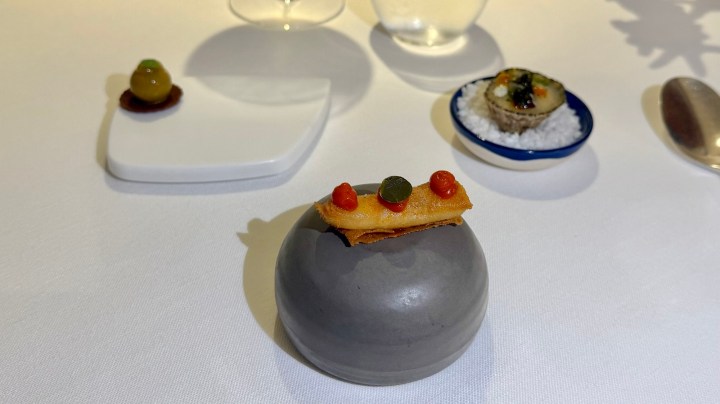
The others were a cannolo filled with dried cod and tomato, a bonbon made from fish liver, and a clam served with raw clam meat and a fresh filling.
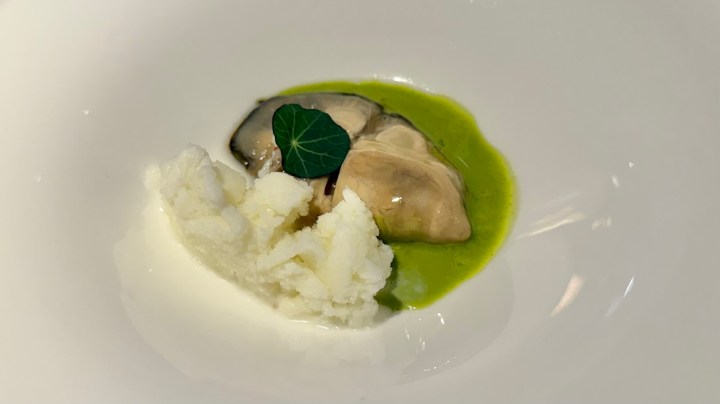
And finally, a French oyster served with a white chocolate granita and an Indian cress sauce. The contrast between the salty oyster, the slightly spicy cress, and the subtly sweet granita was delightful.
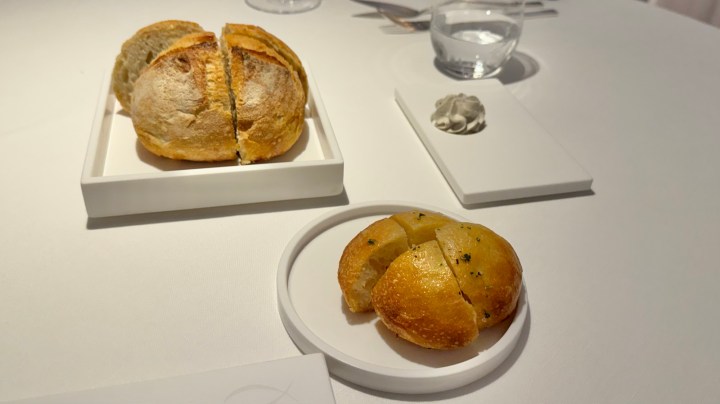
The bread served with the meal was outstanding. The sourdough was only mildly sour (which I like), with a very crunchy crust that wasn’t too thick—as it often is. The focaccia was excellent as well, served in the shape of a bun (and therefore called focaccina). The whipped butter was flavored with anchovies and oregano. Whipped butter has been a trend in restaurants for a while now, and with these wonderful added flavors, it makes more sense to me.
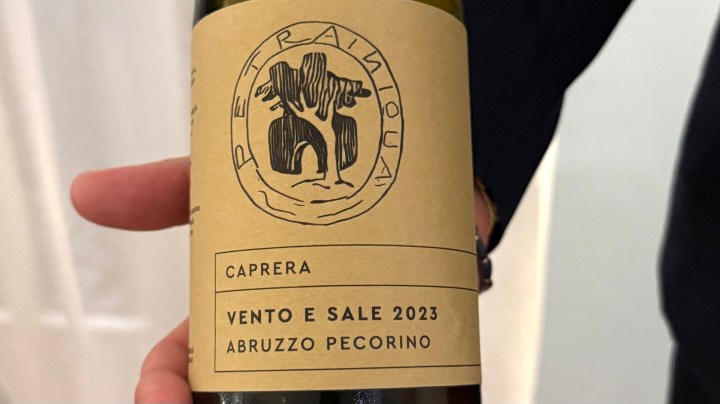
The next wine was a Pecorino from Abruzzo: Vento e Sale 2023 by Caprera, aged on the lees in stainless steel.
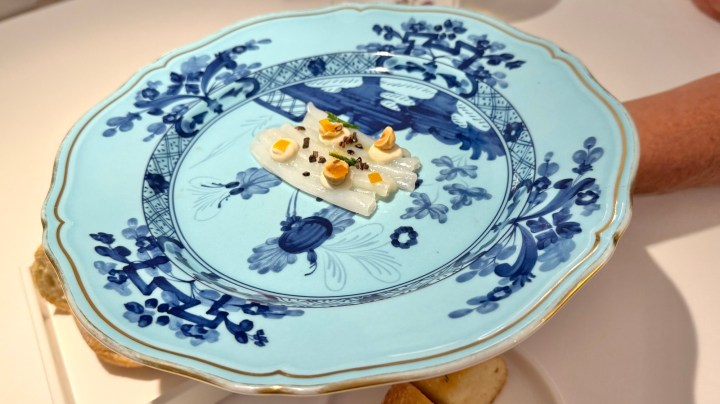
It was a very good pairing with the cuttlefish, served in the style of a torrone with hazelnuts, almond cream, orange peel, and samphire. A torrone is a nougat confection typically made with honey, sugar, and egg white, along with toasted almonds or other nuts. The chef came to the table to present the dish and explained that he had cured the cuttlefish with salt and sugar, then dried it for several hours. So while the cuttlefish was still technically raw, its flavor and texture were enhanced—making it less tough. The combination with the toasted hazelnuts was excellent and also contributed to the successful pairing with the Pecorino, thanks to the wine’s nutty character.
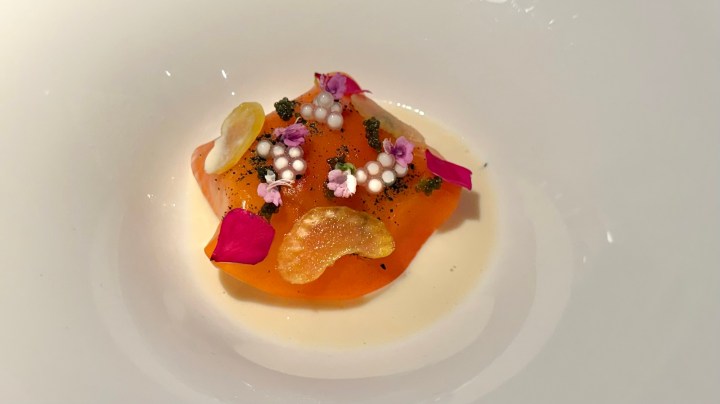
The same Pecorino was also the pairing with the next dish: raw mazzancolle (tiger prawn) topped with a tomato ‘skin’ and served with leche de tigre—a Peruvian marinade made with coconut milk and lime. The prawn meat was impeccably fresh, with a wonderfully unctuous texture that was beautifully complemented by the tomato and leche de tigre.
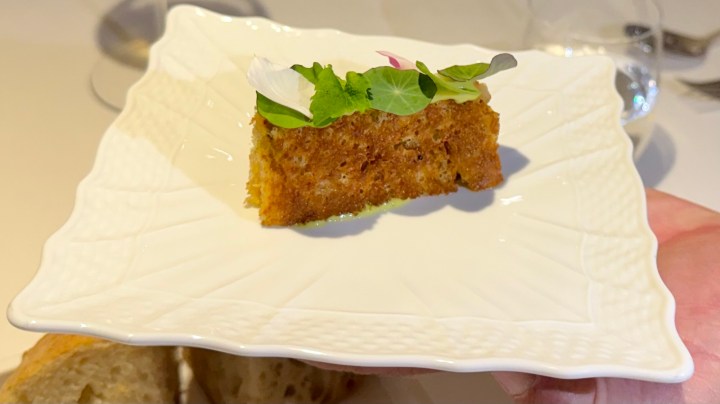
This dish was further elevated by an accompanying piece of toast—very crunchy and filled with prawn meat, with the deep flavor of the prawn shells integrated into the bread.

We continued with a Greco di Bianco from Calabria: Particella 58 by Antonella Lombardo. The names of grape varieties in Italy can be confusing, because Greco Bianco is the same as Pecorello, whereas Greco di Bianco is the same as Malvasia di Lipari. The wine was made with 24 hours of skin contact and then aged for 12 months on the lees in stainless steel. The skin contact gave the wine beautifully fruity and floral aromas.
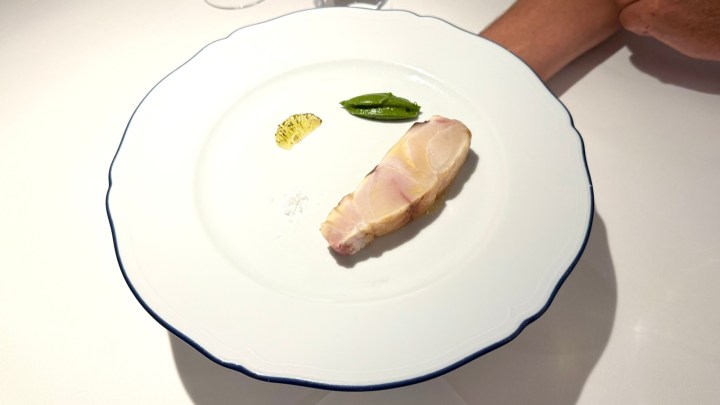
The dish paired with these two wines was a tataki of grouper with a green herb curry and a grilled slice of lemon, accompanied by grilled lettuce with crunchy nuts and a béarnaise sauce on a separate plate. Tataki is a Japanese technique in which the fish is seared over high heat on the outside while remaining raw on the inside. I now understood the purpose of the Laguiole knife provided with the dish—it would have been impossible to slice the raw grouper with a regular fish knife. The flavors complemented each other well,
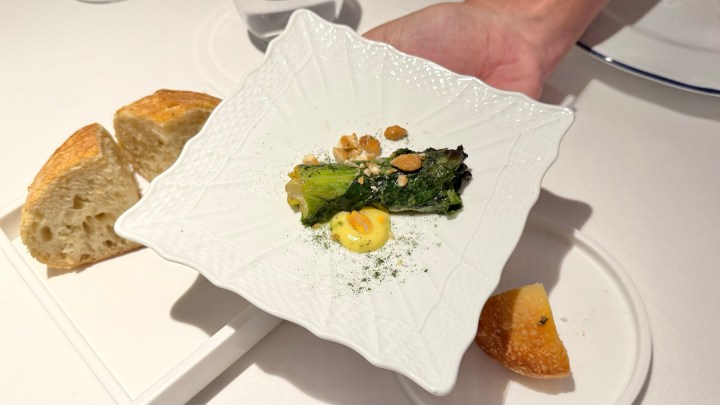
You may have noticed that I photographed all the dishes above the bread in the center of the table, and that Kees was even holding them there. This was because the lighting in the center was much better than at the edge of the table, where the dishes were actually served. It was a smart suggestion by Kees, and it provided better lighting than his usual method of assisting with his phone’s flashlight.
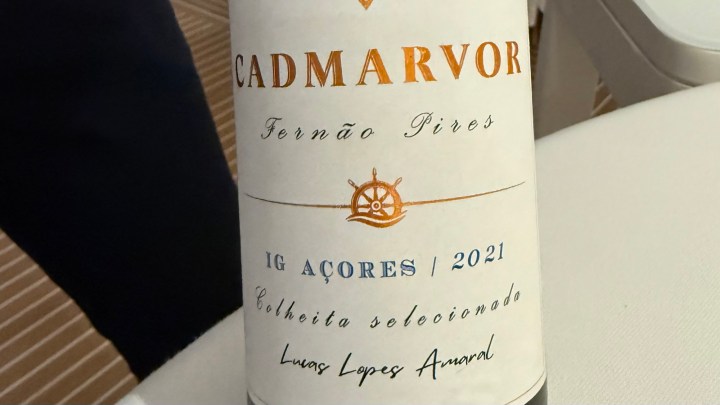
We had asked the sommelier to focus mostly on Italian wines, but for the next dish he selected a Fernão Pires from the Azores: the 2021 Cadmarvor by Lucas Lopes Amaral. Fernão Pires is a grape variety native to mainland Portugal, and this winery is the only one cultivating it on the island of Pico. The wine had wonderful aromas and a pleasant texture.
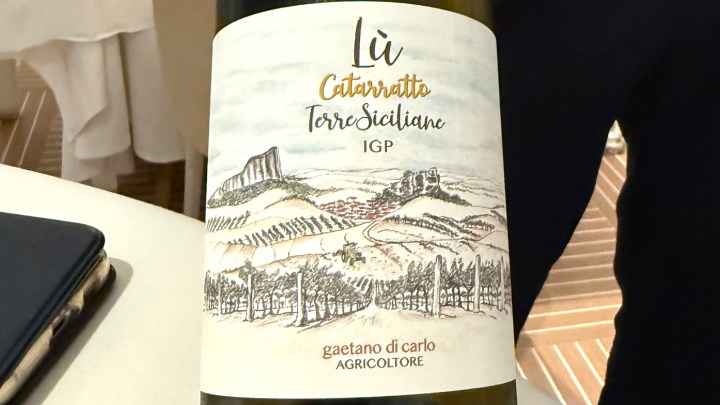
Because of our request, he served a second wine with this dish: a Catarratto from Sicily. It was a pleasant wine as well, though more austere and not quite as enjoyable as the Fernão Pires.
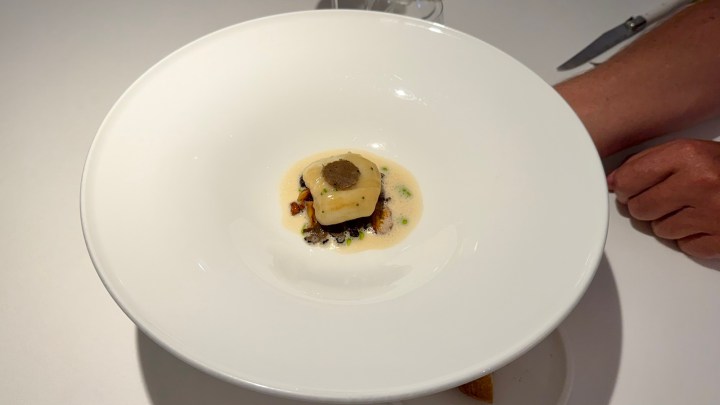
The dish served with these two wines was monkfish cheek with mushrooms, truffle, and a creamy sauce. The Fernão Pires was already a great wine, but the dish really brought out its aromas, making it an excellent pairing. It also paired better with the creamy texture of the dish, whereas that same creaminess accentuated the austerity of the Catarratto from Sicily, which made the wine less enjoyable.

All dishes up to this point were antipasti—now it was time for the primo piatto. The wine served with it was a 2020 Albana from Emilia, aged in amphora, by Al di là del Fiume.
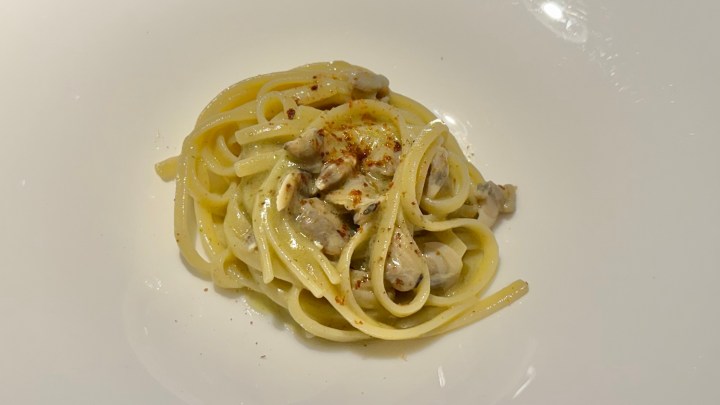
The primo was the chef’s take on the classic linguine alle vongole, enhanced with pine resin and bottarga. The clams were a very small variety called lupini, removed from their shells for easier eating. I’m not sure whether the pine resin was an improvement, but the dish was delicious all the same.
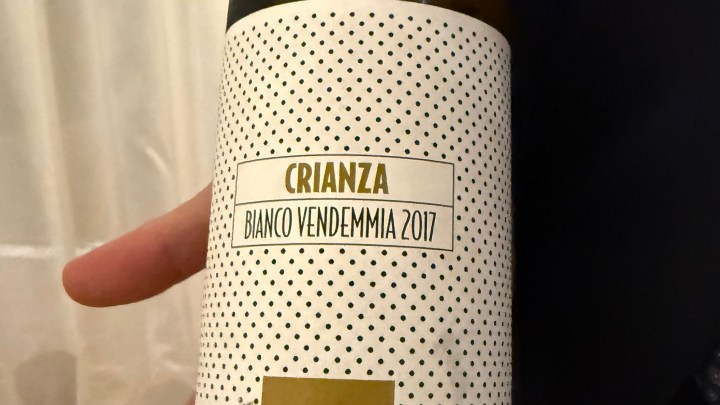
The next wine initially seemed Spanish because it had “Crianza” on the label, but it also said Bianco Vendemmia 2017, so it turned out to be Italian after all. Things got even more confusing when the sommelier mentioned the grape variety was Trebbiano Romagnolo, yet the wine was made in Campania. It was an orange wine, macerated for 40 days, and therefore quite tannic.
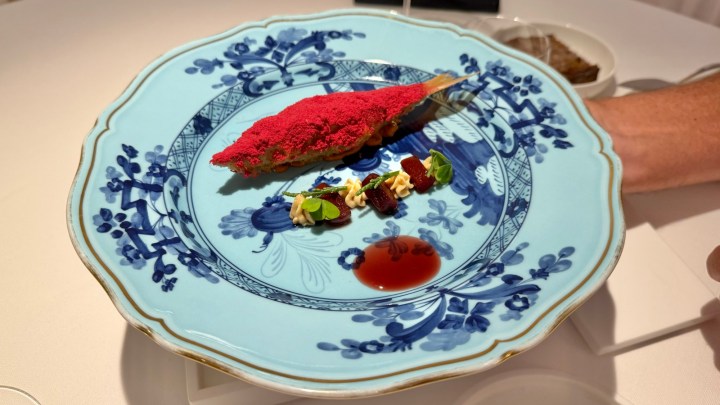
It was not a good pairing for the secondo piatto, which was wonderful on its own: red mullet served as perfect tempura—crispy on the outside and tender on the inside (a true accomplishment, as red mullet can go from undercooked to tough and dry in seconds). It was topped with berry powder, and accompanied by beets and foie gras with cherries. The creaminess of the foie gras intensified the wine’s astringency to the point where it became unpleasant.
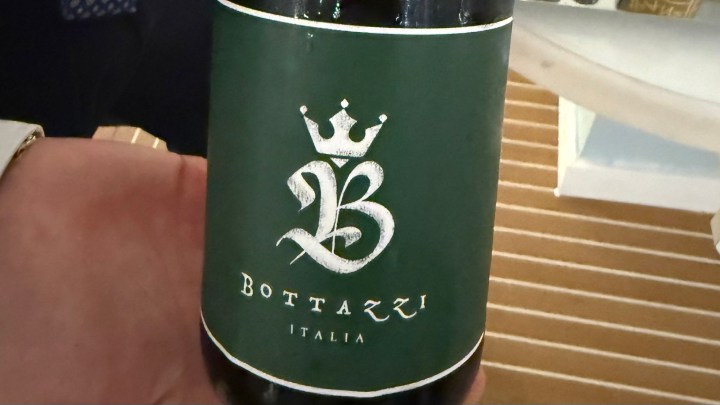
Ms. Melis quickly noticed I wasn’t happy and came to our table to ask what was wrong. The sommelier then brought out a 2016 Italo Derthona Timorasso from the Colli Tortonesi in Piemonte, made by Bottazzi. Although similar in style—Timorasso is also produced with skin maceration, albeit for a much shorter time—this wine had a much creamier texture and paired wonderfully with the dish. The wine’s age also contributed to its excellent performance.
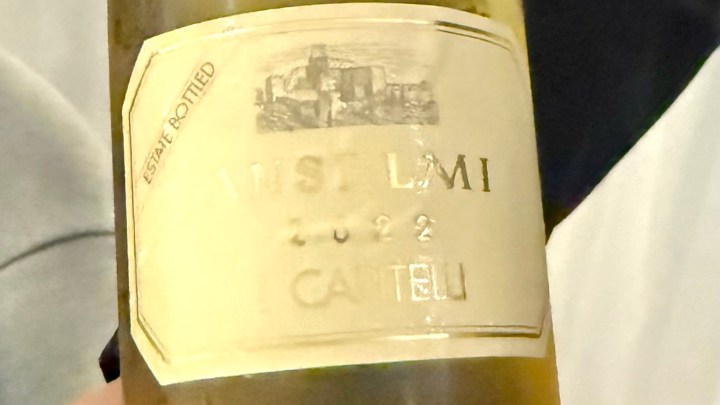
The dessert wine was I Capitelli 2022 by Anselmi, a late-harvest Garganega aged for eight months in barrique, with 154 grams of residual sugar per litre. It resembles a Sauternes, but hails from the vicinity of Lake Garda.
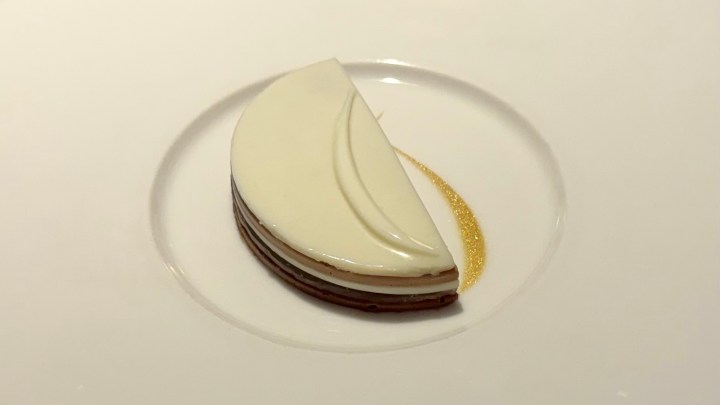
It was a very good pairing with the dessert, which consisted of five layers with varying textures and flavors.

We had a wonderful evening at Pascucci al Porticciolo. This was clearly an example of a tre forchetterestaurant with one Michelin star that, in my opinion, deserves two. The food was excellent, with clear flavors and impeccable freshness and technique. The ‘cuisson’ (degree of doneness) can sometimes be the Achilles heel of Italian chefs, as they tend to err on the side of caution—undercooking pasta and overcooking protein. But Chef Pascucci executed everything perfectly, even the notoriously difficult red mullet. The service was excellent as well: Ms. Melis is not only very cordial and knowledgeable about the dishes and cooking techniques, but also maintains a high level of hospitality. Both the wines and the wine pairings were excellent, which is not always a given in Italy, where pairings often consist of a logical sequence of wines that don’t necessarily complement the dishes. The wines were of high quality, especially compared to what you would get for a €110 wine pairing in the Netherlands. So if you’re flying into or out of Italy via Rome’s Fiumicino airport, I strongly recommend having dinner here. We were there on a Friday night and the restaurant wasn’t even fully booked. I can understand that, as the town of Fiumicino isn’t much of a tourist attraction, but with the airport so close, it’s easy to include in your itinerary. We will certainly be back.


What a wonderful post to fall into the box at the end of a rather difficult day 🙂 ! Love Italian food and seafood and dream of degustation menus and would so much have liked to sit on your shoulder. Like the look of the room and the way the dishes are plated. The tempura and linguine for me please. And the starfish shows such delightful food fun 🙂 ! Hope Tuscany also proved satisfactory in all ways . . .
LikeLiked by 1 person
I am so glad you and Kees got enjoy a lovely meal at Pascucci’s – the reason it might not have been fully booked was probably the time-of-year as opposed to the fact that Fiumicino may not be the ‘prettiest’ town to visit, haha. I am in great admiration of chef Pascucci because he is doing much to safeguard the waters around Fiumicino and together with other well intentioned cooks/chefs in the area have done much to elevate what eating a seafood and fish meal can achieve not just on our tastebuds but on the environment. He features in TV programmes too and seems to be very nice and cordial and not at all stuffy or arrogant. And, maybe not quite at Michelin levels, Fiumicino is becoming quite the foodie spot … We’ve been to Osteria dell’Orologio, not yet to Tino … https://www.lacucinaitaliana.it/gallery/dove-fiumicino-ristoranti-migliori/ and here’s another link:
https://www.vanityfair.it/ristoranti-fiumicino-pesce-tradizione
LikeLiked by 2 people
A truly amazing meal!
LikeLiked by 1 person
I’m actually thinking of staying 1 night around Fiumicino and eat here before heading home. Do you know if they would do substitution? I’m allergic to crustaceans so I cannot eat some of the items on the tasting menu.
LikeLiked by 1 person
I am sure they will accomodate your allergies, especially if you notify them when you make the reservation (make sure to specify if you can eat squid and clams, or only fish). There is also a la carte.
LikeLike
PS we eat everything but Ms Melis specifically mentioned to let her know if we would like any changes.
LikeLike
We stayed in Fiumicino Citta on our last visit to Italy but did not dine out. I shall have to remedy that when we go back 🙂
LikeLiked by 1 person